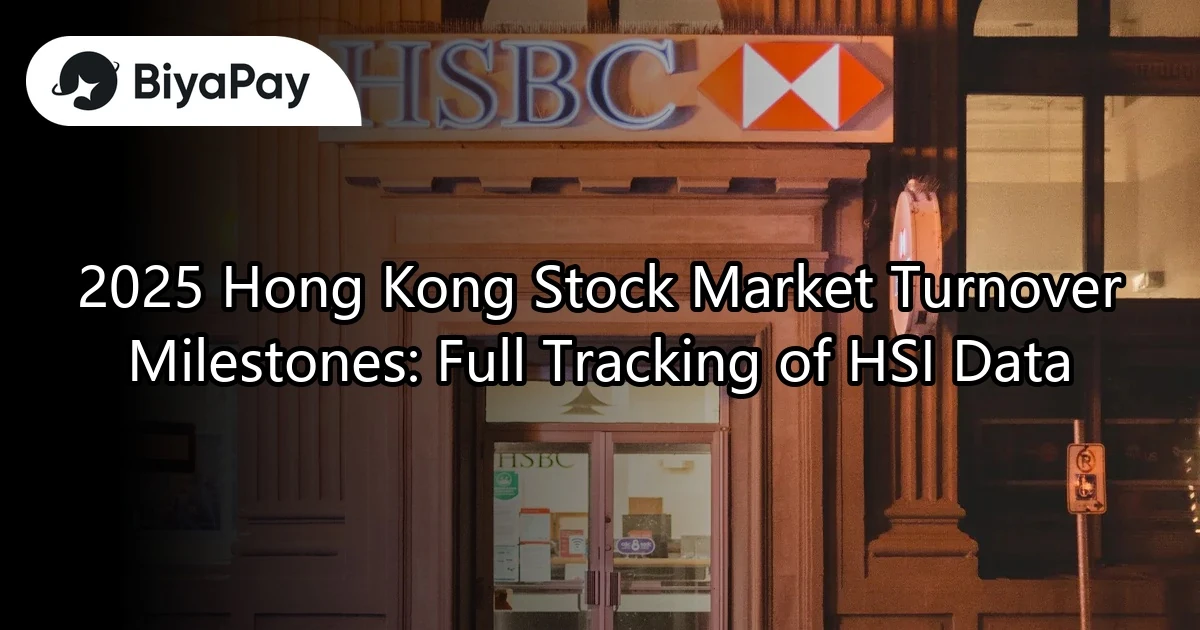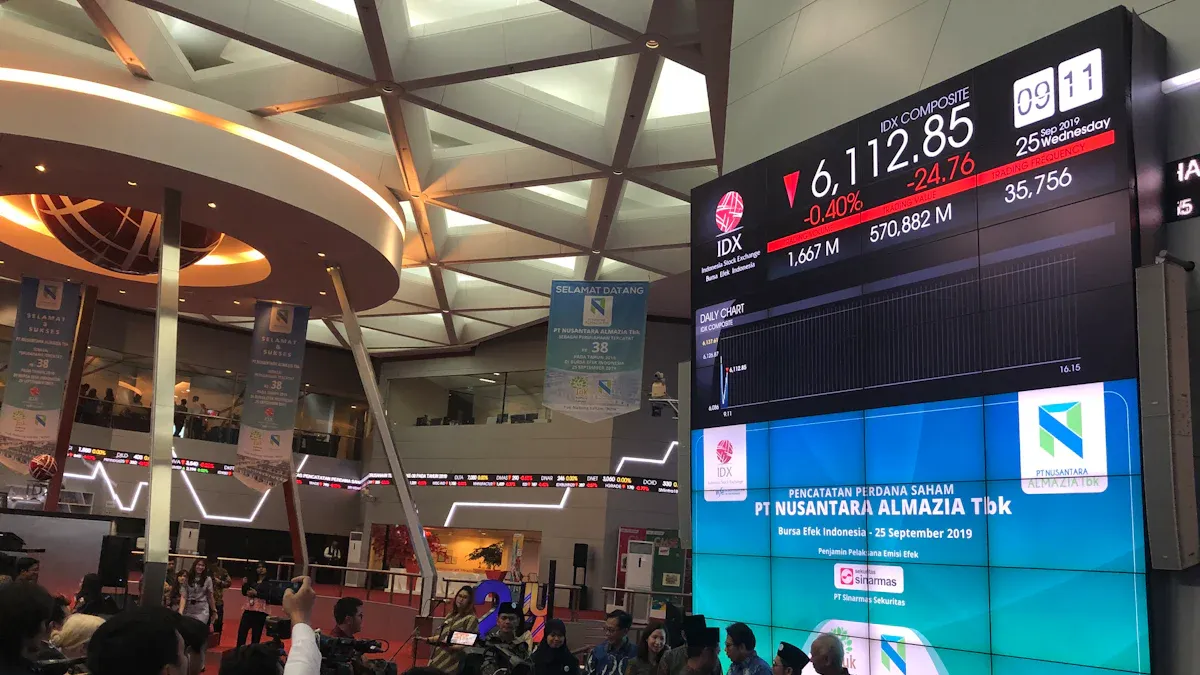- EasyCard
- Trade
- Help
- Announcement
- Academy
- SWIFT Code
- Iban Number
- Referral
- Customer Service
- Blog
- Creator
2025 Hong Kong Stock Market Turnover Milestones: Full Tracking of HSI Data

Image Source: pexels
In 2025, the Hong Kong stock market performed outstandingly, with single-day turnover repeatedly exceeding HK$400 billion, equivalent to approximately USD$51.2 billion (at 1 USD = 7.8 HKD). HSI turnover records show that February’s average daily turnover reached HK$297.2 billion (about USD$38.1 billion), setting a new monthly high. The Hang Seng Index rose by over 3,800 points year-to-date, with a gain of approximately 20%. In February, southbound Stock Connect net purchases reached about USD$19.6 billion, marking the second-highest monthly record in history. Major blue-chip stocks such as China Resources Mixc Lifestyle, Galaxy Entertainment, and Li Auto recorded significant gains.
Key Points
- In 2025, Hong Kong stock market turnover repeatedly set new highs, with a single-day peak of USD$57.2 billion, indicating strong capital inflows and rising investor confidence.
- The tech, financial, and consumer sectors attracted the most capital, accounting for over 60% of total market turnover, serving as the main drivers of HSI gains.
- Mainland Chinese capital continued to flow into Hong Kong stocks, with monthly net purchases peaking at USD$19.6 billion, significantly boosting market activity and turnover growth.
- Favorable policies and diversified financial products drove market activity, and investors should closely monitor policy changes and capital flows to seize investment opportunities.
- The Hang Seng Index and related indices recorded significant gains in 2025, reflecting market structural adjustments and capital rotation trends, with turnover data aiding investor decision-making.
HSI Turnover Records

Image Source: unsplash
Single-Day Highs
In 2025, the Hong Kong stock market recorded multiple single-day turnover highs. On May 27, HSI turnover reached HK$445.7 billion, equivalent to approximately USD$57.2 billion (at 1 USD = 7.8 HKD), marking the highest of the year. On April 7 and January 7, turnover also hit HK$412 billion (about USD$52.8 billion) and HK$398 billion (about USD$51 billion), respectively. These peak days were typically accompanied by significant HSI fluctuations, reflecting highly active market sentiment.
For example, on May 27, the Hang Seng Index rose by over 600 points in a single day, driving substantial capital inflows into tech and financial sectors, pushing turnover to a new high.
Monthly and Average Turnover
In the first five months of 2025, HSI turnover records show sustained market activity. According to the Taiwan Futures Exchange and various financial data platforms, monthly and average daily turnover figures are as follows:
| Month | Average Daily Turnover (HKD) | Average Daily Turnover (USD) |
|---|---|---|
| January | 285 billion | 36.5 billion |
| February | 297.2 billion | 38.1 billion |
| March | 311 billion | 39.9 billion |
| April | 342 billion | 43.8 billion |
| May | 398 billion | 51 billion |
These data can be accessed on the Taiwan Futures Exchange website and major financial reports, covering diverse products like stocks, ETFs, and warrants, providing authoritative support for HSI turnover records.
Key Drivers
The repeated breaking of HSI turnover records was driven by several factors.
- Capital Flows: In 2025, southbound capital net inflows exceeded HK$600 billion (about USD$76.9 billion), reaching over 70% of 2024’s full-year total. Capital mainly flowed into tech, consumer, and financial sectors, boosting market activity.
- Market Activity: Technical indicators like MA, EMA, MACD, and RSI reflect market sentiment. Turnover and large transaction data show active participation by institutional investors, with ETF capital flows also growing steadily.
- Policy and Macroeconomics: The Chinese and Hong Kong governments introduced multiple capital market-friendly policies, attracting international capital inflows. Macroeconomic data such as CPI and non-farm payrolls also influenced capital movements.
- Diverse Products: HSI turnover records include stocks, ETFs, call/put warrants, and depositary receipts, with market product diversification boosting overall turnover.
- Financial Institution Data Validation: Reports and databases from multiple financial institutions use standardized metrics and cross-verified data to ensure the accuracy and reliability of HSI turnover records.
Professional analysis indicates that capital flows and market sentiment indices (e.g., Fear and Greed Index) jointly drove 2025 HSI turnover records to new highs. Investors can track turnover distribution, capital inflows/outflows, and technical indicators to gauge market trends.
Index Performance
Hang Seng Index Trends
In 2025, the Hang Seng Index performed strongly. Starting the year at 19,000 points, it rose to 22,800 points by the end of May, with a cumulative gain exceeding 20%. The market saw multiple single-day sharp fluctuations, particularly during periods of favorable policies and peak capital inflows. The HSI recorded significant rallies in February and May, mainly driven by tech, financial, and consumer sectors. Investors widely noted the phenomenon of turnover rising in tandem with the index, believing capital inflows are closely tied to market confidence.
Other Major Indices
Beyond the Hang Seng Index, other major indices in the Hong Kong stock market also showed notable gains. The H-share Index rose from 6,400 points to 7,800 points in the first five months of 2025, a 22% increase. The Hang Seng Tech Index climbed from 4,200 points to 5,100 points, up about 21%. The Biotech Index also benefited from the new economy stock surge, posting double-digit gains. Cnyes.com’s data on mainland and Hong Kong stocks and global major indices shows that 2025 Hong Kong major indices are highly correlated with turnover changes, reflecting elevated overall market activity.
Annual Changes
In 2025, the Hang Seng Index and related indices saw multiple adjustments to constituent stocks and weightings, reflecting market structural shifts.
- The Hang Seng Index maintained 82 constituents quarterly, with no changes.
- The H-share Index added China Unicom and removed Zhongsheng Group, keeping 50 constituents.
- The Hang Seng Tech Index added Tongcheng Travel and removed GDS Holdings, maintaining 30 constituents.
- The Biotech Index added Lizhu Pharma and WuXi AppTec, removing Huadong Medicine and CanSino Biologics, keeping 50 constituents.
- Constituent weight adjustments: HSBC and Alibaba weights dropped from ~8.9% and 8.3% to 8%, Tencent’s weight rose from 7.94% to 8%, Meituan’s weight fell from 5.84% to 4.23%, and China Mobile’s weight increased from 3.38% to 4.09%.
- The Hang Seng Composite Index reduced constituents from 518 to 514, adding new stocks like Shimao Group, Xuhui Holdings, and Evergrande Property.
These adjustments reflect structural factors in the indices’ annual changes, helping investors understand capital flow and sector rotation trends.
Securities and Sector Distribution

Image Source: pexels
Stocks and Derivatives
In 2025, Hong Kong’s stock market saw rising turnover in both stocks and derivatives. Investors actively participated in stocks, ETFs, call/put warrants, and options. According to market data, May’s monthly stock turnover reached USD$51 billion (at 1 USD = 7.8 HKD), with derivatives like options and futures also hitting record highs. Multiple financial institution reports noted that tech, financial, and consumer stocks were the most sought-after. The derivatives market was active, with investors using options to hedge risks or capture short-term opportunities.
Experts suggest investors refer to databases like Ivy DB OptionMetrics to analyze option prices and turnover, enhancing the scientific basis of trading strategies.
Sector Breakdown
Sector distribution shows that tech, financial, and consumer sectors contributed over 60% of total market turnover. The tech sector benefited from policy support and capital inflows, with turnover steadily rising. The financial sector attracted long-term capital due to stable performance by Hong Kong banks. The consumer sector gained from China’s economic recovery, with leading companies performing strongly.
The table below lists commonly used sector data aggregation databases to assist in analyzing market turnover and sector interactions:
| Database Name | Data Content Summary | Time Range | Usage and Notes |
|---|---|---|---|
| Compustat | Covers securities market financial and trading data, including sector classifications | 2009–present | Accessible via WRDS platform, with user manuals |
| CRSP | Provides historical trading data for stocks and derivatives, ideal for long-term market analysis | 1925–present | Accessible via WRDS platform, requires support contact |
Investors can use these databases to track capital flows and turnover changes across sectors, grasping sector rotation trends.
Mainland Capital Flows
In 2025, capital from mainland China continued to flow into the Hong Kong stock market. Southbound funds recorded a monthly net purchase peak of USD$19.6 billion, setting a historical record. Capital mainly flowed into tech, financial, and consumer sectors, boosting related stock turnover. Analysis shows that capital inflows were closely tied to favorable policies and stable RMB exchange rates.
Market observers believe mainland capital flows have become a key driver of Hong Kong stock turnover growth, and investors should closely monitor the latest changes in capital flows and sector distribution.
Major Events
IPOs
In 2025, the Hong Kong stock market saw a new wave of IPO activity.
- The number of mainland Chinese companies listing in Hong Kong increased significantly, with total funds raised expected to reach about USD$87 billion (at 1 USD = 7.8 HKD).
- The Hong Kong Stock Exchange actively lowered listing thresholds, established dedicated channels, and optimized review processes, attracting more tech, healthcare, and consumer companies to list.
- Deloitte estimated around 80 IPOs for the year, with total funds raised between USD$16.7 billion and USD$19.2 billion.
- These IPOs significantly boosted market turnover, and investors can access detailed data and analysis reports via financial news websites and industry databases.
IPOs not only increased market activity but also provided investors with more diversified investment options, becoming a key driver of 2025 turnover growth.
Northbound Capital Dynamics
In 2025, northbound capital inflows remained a significant source of Hong Kong stock turnover. On May 19, the Commercial Times reported a total Hong Kong stock turnover of about USD$23.7 billion, with northbound net inflows of approximately USD$1.1 billion. Northbound capital inflows significantly boosted index and individual stock performance, particularly in tech and financial sectors.
Investors generally believe that northbound capital dynamics directly influence market sentiment and capital distribution, serving as a key indicator for observing Hong Kong stock turnover changes.
Policy Impact
In 2025, favorable policies were another major driver of amplified Hong Kong stock turnover.
- Approximately 220 Hong Kong-listed companies are expected to achieve “H+A” share listings, reflecting policy-driven market activity.
- Large tech companies like Tencent benefited from favorable policies, significantly increasing market trading activity.
- In early March, Hong Kong stock turnover reached about USD$48.3 billion, with the HSI hitting a three-year intraday high and closing with over a 3% gain.
- This rally was closely tied to policy expectations following China’s National People’s Congress and CPPCC “Two Sessions,” with investors widely anticipating more measures to support economic growth.
Analysts note that under policy support, the Hong Kong stock market’s structure and turnover have seen significant changes, with short-term upside potential remaining. Investors should continue monitoring policy developments and their profound market impacts.
Historical Rankings
Top 10 Turnover Days
In 2025, the Hong Kong stock market saw multiple days with record-breaking turnover. Below is the annual top 10 single-day turnover ranking, all calculated at 1 USD = 7.8 HKD:
| Rank | Date | Single-Day Turnover (HKD) | Single-Day Turnover (USD) |
|---|---|---|---|
| 1 | May 27 | 445.7 billion | 57.2 billion |
| 2 | April 7 | 412 billion | 52.8 billion |
| 3 | March 5 | 408.3 billion | 52.3 billion |
| 4 | February 21 | 405 billion | 51.9 billion |
| 5 | January 7 | 398 billion | 51 billion |
| 6 | May 19 | 395 billion | 50.6 billion |
| 7 | April 15 | 390 billion | 50 billion |
| 8 | March 28 | 385 billion | 49.3 billion |
| 9 | February 28 | 382 billion | 49 billion |
| 10 | January 22 | 380 billion | 48.7 billion |
These high-turnover days were often linked to policy announcements, peak capital inflows, or major IPOs. Market experts suggest investors closely monitor turnover anomalies to capture potential opportunities.
Index Highs and Lows
In 2025, the Hang Seng Index showed significant volatility, recording both new highs and lows. Below are key annual index points:
- Year-to-date high: 22,950 points (May 28)
- Year-to-date low: 18,700 points (January 3)
The Hang Seng Tech Index also hit a new high, reaching 5,180 points on May 29. The H-share Index peaked at 7,850 points.
These data reflect gradually recovering market confidence. Analysts note that index highs often coincide with capital inflows and amplified turnover.
Capital Inflow Rankings
The 2025 capital inflow rankings show that tech, financial, and consumer sectors were the most favored. According to market statistics, the top five stocks by annual capital inflows were:
- Tencent Holdings (Tech) — Capital inflow: ~USD$8.2 billion
- HSBC Holdings (Financial) — Capital inflow: ~USD$7.6 billion
- Alibaba (Tech) — Capital inflow: ~USD$6.9 billion
- Meituan (Consumer) — Capital inflow: ~USD$6.1 billion
- China Mobile (Telecom) — Capital inflow: ~USD$5.8 billion
Professional institutions suggest investors refer to capital inflow rankings to identify market hotspots and mainstream capital directions, improving investment decision efficiency.
In 2025, the Hong Kong stock market remained highly active, with HSI turnover records repeatedly broken, reflecting strong capital inflow momentum. Tech, financial, and consumer sectors continued to be sought after, with significant index volatility. Experts recommend that investors closely monitor policy changes and capital flows, continuously track HSI turnover records, and stay informed about the latest market trends.
FAQ
Did Hong Kong stock turnover set new highs in 2025?
On May 27, 2025, Hong Kong stock single-day turnover reached approximately USD$57.2 billion (at 1 USD = 7.8 HKD), setting a historical record.
How did the Hang Seng Index perform this year?
The Hang Seng Index started the year at 19,000 points and rose to 22,800 points by the end of May, with a cumulative gain of about 20%. Tech and financial sectors drove the rally.
Which sectors attracted the most capital?
- Tech
- Financial
- Consumer
These three sectors drew the most capital, accounting for over 60% of turnover.
How did mainland capital impact Hong Kong stocks?
Capital from mainland China continued to flow in, with a monthly net purchase peak of about USD$19.6 billion in 2025, significantly boosting tech and financial sector turnover.
Where can Hong Kong stock turnover data be accessed?
Investors can check the latest turnover and index data on the Hong Kong Stock Exchange, Taiwan Futures Exchange, and major financial data platforms.
In 2025, Hong Kong’s stock market hit record transaction volumes (up to USD 572 billion), with the Hang Seng Index soaring 20%, driven by tech and financial sectors. BiyaPay empowers you to trade U.S. stocks, Hong Kong stocks, and Hang Seng ETFs on a single platform without overseas accounts—start now at BiyaPay! With transaction fees as low as 0.5% and real-time USD conversions across 190+ countries, it’s cost-effective.
Track transaction volumes and fund flows with its economic calendar to seize opportunities. Its 5.48% annualized yield wealth product offers flexible withdrawals. Regulated internationally, it ensures secure trading. Visit BiyaPay today to capitalize on the Hong Kong market boom!
*This article is provided for general information purposes and does not constitute legal, tax or other professional advice from BiyaPay or its subsidiaries and its affiliates, and it is not intended as a substitute for obtaining advice from a financial advisor or any other professional.
We make no representations, warranties or warranties, express or implied, as to the accuracy, completeness or timeliness of the contents of this publication.




Contact Us
Company and Team
BiyaPay Products
Customer Services
is a broker-dealer registered with the U.S. Securities and Exchange Commission (SEC) (No.: 802-127417), member of the Financial Industry Regulatory Authority (FINRA) (CRD: 325027), member of the Securities Investor Protection Corporation (SIPC), and regulated by FINRA and SEC.
registered with the US Financial Crimes Enforcement Network (FinCEN), as a Money Services Business (MSB), registration number: 31000218637349, and regulated by FinCEN.
registered as Financial Service Provider (FSP number: FSP1007221) in New Zealand, and is a member of the Financial Dispute Resolution Scheme, a New Zealand independent dispute resolution service provider.



















